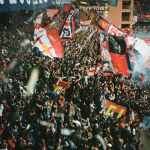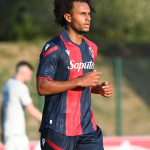
Why in Italy we fail to take racism seriously
And how Gasperini's words go backwards
May 9th, 2023
Just over a month has passed since the racial slurs against Romelu Lukaku, with the Inter striker's exclusion (later withdrawn) with the second yellow card he received for his provocative cheer towards the opposition corner, and now the sad script is wearily repeating itself in Bergamo. This time it was Juventus player Dusan Vlahovic who was racially insulted on the pitch for being of Serbian descent after a confrontation with Atalanta player Maehle. The chants, which could also be clearly heard on television, were so violent that they prompted referee Doveri to suspend the game in accordance with the rules. Immediately afterwards, however, the game resumed without the Bergamo fans stopping to insult Vlahovic's ethnicity, despite pleas from some players in the stands. Then, in the final minutes, also caused by the stoppage of play because of the chants, the Serbian player found the Bianconeri's brace with a surgical left-footed shot on the counter-attack and could not even cheer when Doveri stopped him, as if he had foreseen Vlahovic's possible reaction and later cautioned him. As with Lukaku, the victim became the punished.
This recurring behaviour shows that the theory of a few bad apples is in reality a cowardly hand-washing compared to the gigantic problem that Italian football has not even begun to deal with. Because despite all the lip service, every time the issue of racism is raised in an Italian stadium, what hurts most is the tone and the demonstrations that follow. They testify to the ignorance and cowardice of some people who only go to the stadium to insult the opposing footballers, with the same rudeness often masquerading as hairy paternalism or slavish respect for the rules. This is exactly what Atalanta coach Gasperini demonstrated, who, perhaps to protect his own fans, got up on the proverbial mirror in front of the cameras at the end of the match and suggested a distinction between insults and racism, pointing out that his team includes several players from the Balkans, such as Pasalic, Djimsiti, Ilicic, Sutalo.
Gasperini's speech, no stranger to this kind of outburst, confirms a widespread thinking in Italian football that always tries to sweep the dust under the carpet, hide behind bureaucracy and divide the blame between victim and executioner with Solomonic precision. An abused and tired little theatre that reveals all the ignorance and mediocrity of those in power in Italy, who advocate constant awareness campaigns, but when it comes to putting them into practise, when a real and courageous stance is really called for, it starts staging ifs and buts again. On the other hand, one can not expect much from a football league that launches initiatives like artist Simone Fugazzotto's Monkeys, one of the most surreal moments in Italian football, which shows that there are not really the intellectual and emotional means to sympathise with the victims of racist hatred. Vlahovic is no different to Lukaku, who in turn is no different to Moise Kean or Koulibaly. Just as the Gewiss stadium is no different from the Juventus stadium, the Sant'Elia or the Stadio Olimpico, the fans are not made up of a few rotten apples, but of a sentiment that runs through a part of Italian football and the country and that demands different answers than those given by Gasperini.












